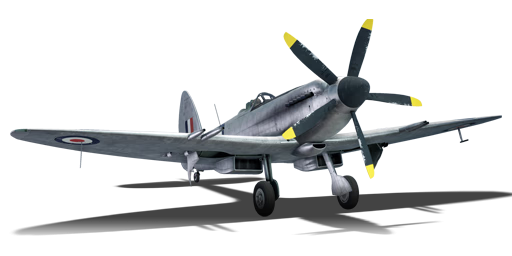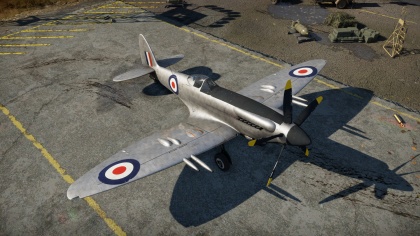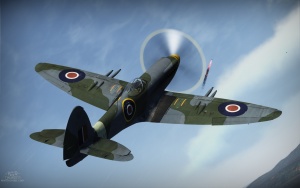Difference between revisions of "Spitfire F Mk 24"
(→Offensive armament: Corrected as of Update 1.87) |
Inceptor57 (talk | contribs) (Added relevance notice pending spec card change) |
||
| Line 1: | Line 1: | ||
| + | {{Relevance}} | ||
{{Specs-Card|code=spitfire_f24}} | {{Specs-Card|code=spitfire_f24}} | ||
{{Notice|''This page is about the aircraft '''{{PAGENAME}}'''. For other uses, see [[Spitfire_(Disambiguation)|Spitfire (Disambiguation)]]''}} | {{Notice|''This page is about the aircraft '''{{PAGENAME}}'''. For other uses, see [[Spitfire_(Disambiguation)|Spitfire (Disambiguation)]]''}} | ||
Revision as of 17:35, 13 March 2019
| Relevance under question. The content of this article is most likely outdated and is not reflecting the current state of affairs. The article needs to be updated. |
Contents
| This page is about the aircraft Spitfire F Mk 24. For other uses, see Spitfire (Disambiguation) |
Description
The Spitfire F Mk 24 is a Rank IV British fighter
with a battle rating of 6.3 (AB) and 6.7 (RB/SB). It was introduced in Update 1.39.
The Spitfire F Mk.24's Rolls-Royce Griffon engine is the fighter's greatest asset, but it is still very agile at medium speeds of around 400-500 kph. When the Mk.24 cannot make use of its Griffon engine it is highly vulnerable, so pilots should take care to avoid situations where speed and acceleration is a non-factor in victory.
General info
Flight Performance
| Characteristics | |||||||
|---|---|---|---|---|---|---|---|
| Stock | |||||||
| Max Speed (km/h at 8,232 m) |
Max altitude (meters) |
Turn time (seconds) |
Rate of climb (meters/second) |
Take-off run (meters) | |||
| AB | RB | AB | RB | AB | RB | ||
| 715 | 698 | 11,800 | 19.6 | 20.0 | 17.3 | 19.8 | 420 |
| Upgraded | |||||||
| Max Speed (km/h at 8,232 m) |
Max altitude (meters) | Turn time (seconds) | Rate of climb (meters/second) |
Take-off run (meters) | |||
| AB | RB | AB | RB | AB | RB | ||
| 832 | 777 | 11,800 | 17.7 | 17.6 | 44.1 | 28.3 | 420 |
Details
| Features | ||||
|---|---|---|---|---|
| Combat flap | Take-off flap | Landing flap | Air brakes | Arrestor gear |
| ✓ | ✓ | ✓ | X | X |
| Limits | ||||
|---|---|---|---|---|
| Wing-break speed (km/h) |
Gear limit (km/h) |
Combat flap (km/h) |
Max Static G | |
| + | - | |||
| 875 | 260 | ??? | ~12 | ~7 |
| Optimal velocities | |||
|---|---|---|---|
| Ailerons (km/h) |
Rudder (km/h) |
Elevators (km/h) |
Radiator (km/h) |
| < 482 | < 400 | < 470 | > 250 |
| Compressor (RB/SB) | ||
|---|---|---|
| Setting 1 | ||
| Optimal altitude | 100% Engine power | WEP Engine power |
| 4,600 m | 1,510 hp | 2,190 hp |
| Setting 2 | ||
| Optimal altitude | 100% Engine power | WEP Engine power |
| 8,600 m | 1,360 hp | 1,993 hp |
Survivability and armour
- 3 mm Steel - Armor plating ammo cover (both wings)
- 6 mm Steel - Upper prop hub plate
- 12.7 mm Steel - Fore cockpit armor plate
- 4 mm Steel - Pilot's seat
- 7 mm Steel - Behind pilot's seat
- 4 mm Steel - Pilot's headrest
- 42.8 mm Bulletproof glass - Armored windscreen
Armaments
Offensive armament
The Spitfire F Mk 24 is armed with:
- 4 x 20 mm Hispano Mk.II cannon, wing-mounted (175 inner + 150 outer rpg each wing = 650 total)
Suspended armament
The Spitfire F Mk 24 can be outfitted with the following ordinance
- Without load
- 2 x 250 lb G.P. Mk.IV bombs (500 lb total)
- 3 x 250 lb G.P. Mk.IV bombs (750 lb total)
- 2 x 500 lb G.P. Mk.IV bombs (1,000 lb total)
- 2 x 250 lb G.P. Mk.IV bombs + 1x 500 lb G.P. Mk.IV bombs (1,000 lb total)
- 3 x 500 lb G.P. Mk.IV bombs (1,500 lb total)
- 8 x 76 mm RP-3 rockets
- 4 x 76 mm RP-3 rockets and 2 x 250 lb G.P. Mk.IV bombs (500 lb total)
Usage in the battles
The Spitfire F Mk.24 is an outstanding plane in realistic battles with few weaknesses, meaning the enemy will have a really hard time either catching the Mk.24 or shaking it off of their tail, and only the most skilled of opponents will stand a chance.
It is very important to avoid hard turning or rolling above 500 kph as the plane risks shearing its wings. It is also very important to monitor your energy state as the Spitfire F Mk.24 is a relatively large fighter aircraft and will be a big target at low speeds.
The main task for a Mk.24 pilot is to utilize the immense power of the Rolls-Royce Griffon engine, which allows the Spitfire to climb at an insanely high rate. The pilot should always use his climb rate to his advantage in combat, using his altitude to dictate the terms of an engagement. Target altitude should usually be around 5-6 km on smaller maps and 6-7 km on larger maps such as Norway or Spain where the Griffon engine will perform optimally.
The Spitfire F Mk.24's main combat tactic is Boom & Zooming due to its outstanding speed, armament, and engine output. Because of the last point, Energy fighting is an option open to the Mk.24 as well, when engaging an enemy separated from his team. The Rolls-Royce Griffon engine is what opens the Spitfire F Mk.24 to both of these tactics. Not only does the Griffon engine bestow the Mk.24 with an incredible top speed, it also causes the fighter to accelerate incredibly fast allowing it to keep its speed for longer even in a sharp climb.
Although boom-and-zooming and energy fighting are the main tactics of the Spitfire F Mk.24, the fighter is also able to keep up with most enemies in turn fights with few exceptions (namely Japanese fighters). Try to maintain a speed of between 400-500 kph; this is where the plane maintains a high turn rate. Turning below this velocity against planes such as the Bf 109 G-14 is not recommended. It is important to note that the Mk.24 should avoid combat at low altitude especially versus Soviet Fighters who excel below 4 km. The Spitfire F Mk.24's strength is at high altitude combat, where it can abuse the power of its Griffon engine.
Manual Engine Control
| MEC elements | ||||||
|---|---|---|---|---|---|---|
| Mixer | Pitch | Radiator | Supercharger | Turbocharger | ||
| Oil | Water | Type | ||||
| Controllable | Not controllable | Not controllable | Not controllable | Separate | Not ontrollable | Not controllable |
Modules
| Tier | Flight performance | Survivability | Weaponry | ||
|---|---|---|---|---|---|
| I | Fuselage Repair | Radiator | HSBC mk.2 | HSBC mk.3 | |
| II | Compressor | Airframe | HMBC mk.2 | HMBC mk.3 | |
| III | Wings Repair | Engine | Offensive 20 mm | HRC mk.8 | |
| IV | 150 Octane Fuel | Engine Injection | Cover | New 20 mm Cannons | |
- The Spitfire F Mk.24's performance relies on its engine and that should thus be the focus of research. It is recommended you progress through your research in the following order.
- Fuselage Repair
- Radiator
- Compressor
- Airframe
- Offensive 20 mm
- Engine
- Engine Injection
- 150 octane fuel
- Wings repair
- Cover
After you have researched all of the above, complete the remaining research in any order. The Offensive 20 mm upgrade is incredibly useful due to the power of Air Targets on Hispano Mk.V cannons, which is why it is prioritized over the Engine upgrade even with the focus on engine-related upgrades.
Pros and cons
Pros:
- Powerful engine which provides incredible climb rate, good acceleration and top speed
- Equipped with 4 x 20 mm Hispano Mk.V cannons, which are highly powerful and have a high rate of fire
- Incredible at energy fighting
- Performs extremely well at medium to high altitudes
- Excellent acceleration in a dive
- High turn rate at medium speeds (approximately 500 kph/311 mph)
- Identical to the Mk 22 model with the exception of added 150 octane fuel and chrome paint scheme
- Can pretty much decimate everything it encounters when played properly
- Is an excellent jet killer
- Very good roll rate
- Wing rip speed is 875 kph/544 mph
- Infinite WEP duration
- Works well with manual engine control
Cons
- Armament is mounted on the wings
- Wings are highly susceptible to shearing at higher speeds
- WEP causes the plane to consume fuel at a fast rate
- Suffers at lower altitudes where the engine isn't operating at full potential
- Extremely poor low speed performance
- Under wing radiators create a large amount of drag, especially when open
History
Describe the history of the creation and combat usage of the aircraft in more detail than in the introduction. If the historical reference turns out to be too big, take it to a separate article, taking a link to an article about the vehicle and adding a block "/ historical reference" (example: https://wiki.warthunder.com/Name-vehicles/historical reference) and add a link to it here using the main template. Be sure to include links to sources at the end of the article.
Media
An excellent addition to the article will be video guides, as well as screenshots from the game and photos.
Read also
Links to the articles on the War Thunder Wiki that you think will be useful for the reader, for example,
- reference to the series of the aircraft;
- links to approximate analogues of other nations and research trees.
Sources
Paste links to sources and external resources, such as:
- topic on the official game forum;
- page on aircraft encyclopedia;
- other literature.






